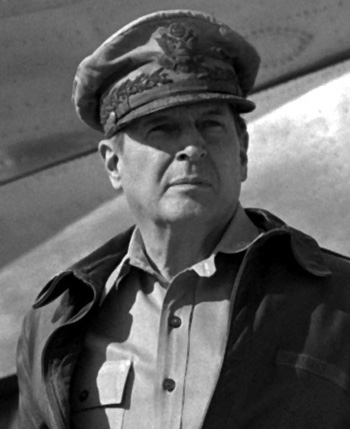
|
Douglas MacArthur |
 |
|||
| Rank, Service | ||||
General of the Army, U.S. Army |
||||
| Veteran of: | ||||
|
||||
| Tribute: | ||||
Douglas MacArthur was born on January 26, 1880, in Little Rock, Arkansas. He entered the U.S. Military Academy at West Point on June 13, 1899, and graduated first in his class with a commission as a 2LT in the Corps of Engineers on June 11, 1903. His first assignment was as an engineering officer with the 3rd Battalion of Engineers in the Philippines from June 1903 to October 1904, followed by duty as Chief Engineering Officer of the Pacific Division in San Francisco, California, from October 1904 to August 1905. MacArthur then served as Aide-de-Camp to his father, Maj Gen Arthur MacArthur, from August 1905 to August 1906, and then served as Aide to President Theodore Roosevelt from September 1906 to August 1907. He attended the Engineer School of Application in Washington, D.C., from August 1907 to February 1908, and then served as Assistant Engineer and then Officer in Charge of Improvements to Harbors in Milwaukee, Wisconsin, from February to April 1908. MacArthur was Commanding Officer of Company K, 3rd Battalion of Engineers, and then an Instructor at Fort Riley and Fort Leavenworth, Kansas, from April 1908 to April 1909. He then served as Adjutant and Quartermaster with the 3rd Battalion of Engineers at Fort Leavenworth from April 1909 to November 1912. MacArthur served on the General Staff in Washington, D.C., from November 1912 to September 1917, and during this time he participated in the Vera Cruz Expedition from April to August 1914. MacArthur next transferred to the Infantry Branch and became Chief of Staff of the 42nd (Rainbow) Division at Camp Mills, New York, in September 1917, and and went with the Division to France for World War I. He was promoted to Brigadier General and made Commanding General of the 84th Infantry Brigade in August 1918, and then Commander of the 42nd Division. After World War I, Gen MacArthur became Superintendent of the U.S. Military Academy, where he served from June 1919 to July 1922. He next served as Commanding General of the District of Manila in the Philippines from October 1922 to July 1923, when he became Commander of the 23rd Infantry Brigade at Fort McKinley, also in the Philippines, until January 1925. Gen MacArthur served as Commander of IV Corps Area in Atlanta, Georgia, and then III Corps Area in Baltimore, Maryland, between May 1925 and September 1928, and then served as Commanding General of the Philippine Department in Manila from October 1928 to September 1930. He was Commanding General of XX Corps Area in San Francisco from October to November 1930, and became Chief of Staff of the Army on November 21, 1930. He served in this position until October 1935, when he returned to the Philippines to serve as military advisor. MacArthur retired from the Army on December 31, 1937, and was made Field Marshal of the Philippine Army. President Roosevelt recalled him to active duty on July 26, 1941, and appointed him Commanding General, U.S. Army Forces in the Far East. After escaping from the Philippines, Gen MacArthur was made Supreme Commander of the Southwest Pacific and Pacific Area in April 1942. He led allied forces through most of the major battles in the Pacific during WWII, and accepted the Japanese Surrender on the battleship USS Missouri in Tokyo Bay on September 2, 1945. He was made Supreme Allied Commander in Chief of Allied Forces in Japan in August 1945, and after the outbreak of the Korean War he also became Commanding General of the United Nations Command, Far East, in July 1950. He was relieved of his command in April 1951, and returned to the United States, the first time he had been in the U.S. in 14 years. As a General of the Army, MacArthur would remain on the active duty rolls of the military for life, and he was assigned to the Office of the Chief of Staff of the Army from August 1951 until his death at Walter Reed Army Hospital on April 5, 1964. Douglas MacArthur and his wife Jean are interred together in the MacArthur Memorial in Norfolk, Virginia. He was the son of Army Lt Gen Arthur MacArthur, and they are one of only two father-and-sons to have both been awarded the Medal of Honor. |
||||
|
||||

